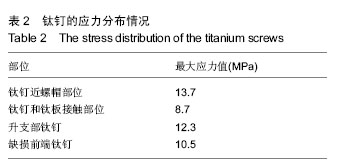| [1] 王玉龙,韩龙,毛驰.下颌骨缺损的修复重建[J].口腔颌面修复学杂志,2011,12(2):126-128.
[2] 徐宝成. 下颌骨缺损修复及重建临床研究[J]. 亚太传统医药,2011,7(10):151-152.
[3] Ardila JE, Torres T, Torres C,et al. Mandibular Reconstruction in a Patient With Rosai-Dorfman Disease.J Craniofac Surg. 2016;27(1):e13-17.
[4] 高科央.自体骨移植修复重建下颌骨缺损的临床研究[J].中国现代医生,2011,49(27):15-16.
[5] Lonie S, Herle P, Paddle A,et al. Mandibular reconstruction: meta-analysis of iliac- versus fibula-free flaps.ANZ J Surg. 2016;86(5):337-342.
[6] 季彤,铁英,王冬梅,等.下颌骨缺损腓骨重建的三维有限元应力分析[J].华西口腔医学杂志,2009,27(2):143-146.
[7] 邓永强,郑苍尚,朱耀旻,等.腓骨及髂骨组织瓣在修复下颌骨缺损的应用比较研究[J]. 口腔医学研究, 2013,29(6): 569-571.
[8] 陈旭兵. 游离腓骨瓣楔形截骨术在下颌骨重建中的应用[J].中国口腔颌面外科杂志,2013,11(4):325-328.
[9] Wu JQ, Liu J, Wang LL,et al. Bone histomorphometry detection of autologous bone powder graft repair of partial mandibular defects in rabbits. Genet Mol Res. 2015;14(4):13812-13822.
[10] 刘雄.下颌骨体部缺损腓骨重建小钛板固定的生物力学分析[D].广州:南方医科大学,2014.
[11] 桑炜荣.血管化游离髂骨瓣在下颌骨重建中的临床应用研究[D].杭州:浙江大学,2014.
[12] 吴双江.口腔颌面肿瘤术后骨与软组织缺损修复重建的临床研究[D].泸州:泸州医学院,2012.
[13] 米磊,刘怀勤.下颌骨缺损修复重建的研究进展[J].中国美容医学,2015,24(8):87-90.
[14] 卢保全,张凯,胡浩.肿瘤术后下颌骨缺损的成型钛板即刻修复重建[J].口腔医学,2008,28(1):25-27.
[15] 冯晓东,刘中寅,蒋子超,等. 重建钛板修复下颌骨缺损术后32例失败的临床分析[J].中国医疗美容, 2015,5(1): 140-141.
[16] Rahimov C, Farzaliyev I.Virtual bending of titanium reconstructive plates for mandibular defect bridging: review of three clinical cases.Craniomaxillofac Trauma Reconstr. 2011;4(4):223-234.
[17] 藕小平,陈伟良,张胜,等.下颌重建钛板即刻修复下颌骨缺损26例[J].口腔医学,2010,30(2):124-125.
[18] 孙铁忠,王鹏来,刘超,等.重建钛板在修复下颌骨缺损中的临床应用[J].中国校医,2011,25(10):789-790.
[19] 刘峰,黄迪炎,马杰,等.下颌骨缺损钛重建板修复的生物力学分析[J].中国组织工程研究与临床康复, 2010,14(35): 6504-6507.
[20] 章臻,潘巨利,黄欣,等.下颌骨缺损的个体化修复重建[J].口腔颌面外科杂志,2014,24(4):293-296.
[21] 王翔,朱飞,尚政军.35例自体髂骨同期修复重建下颌骨缺损回顾性分析[J].临床口腔医学杂志, 2013,29(6): 351-353.
[22] 余西江,唐永刚.下颌骨缺损的外形重建与功能修复的研究[J].中国医疗美容,2015,5(3):21-23.
[23] Goulart DR, Kemmoku DT, Noritomi PY, et al. Development of a Titanium Plate for Mandibular Angle Fractures with a Bone Defect in the Lower Border: Finite Element Analysis and Mechanical Test.J Oral Maxillofac Res. 2015;6(3):e5.
[24] Tarsitano A, Del Corso G, Ciocca L, et al. Mandibular reconstructions using computer-aided design/ computer-aided manufacturing: A systematic review of a defect-based reconstructive algorithm.J Craniomaxillofac Surg. 2015;43(9):1785-1791.
[25] Murakami K, Yamamoto K, Sugiura T,et al. Biomechanical analysis of poly-L-lactic acid and titanium plates fixated for mandibular symphyseal fracture with a conservatively treated unilateral condylar fracture using the three-dimensional finite element method. Dent Traumatol. 2015;31(5):396-402.
[26] 赵玺,韩蕊,米丛波.三维有限元法在口腔正畸生物力学研究中的应用[J].中国实用口腔科杂志,2011,4(2):116-118.
[27] 程林,何惠宇. 三维有限元法在牙列缺损修复中的应用[J]. 国际口腔医学杂志,2012,39(2):230-232.
[28] Tjoa T, Manuel CT, Leary RP, et al. A Finite Element Model to Simulate Formation of the Inverted-V Deformity. JAMA Facial Plast Surg. 2016;18(2):136-143.
[29] Esmaeili Monir H, Yamada H, Sakata N. Finite element modelling of the common carotid artery in the elderly with physiological intimal thickening using layer-specific stress-released geometries and nonlinear elastic properties.Comput Methods Biomech Biomed Engin. 2016;19(12):1286-1296.
[30] 吴志芳,雷勇华.三维有限元法在口腔正畸中的应用和展望[J].国际口腔医学杂志,2013,40(6):804-807.
[31] 张婉君,李金源,马永平,等.口腔正畸中三维有限元法的发展[J].医学研究与教育,2015,32(3):75-81.
[32] 白石柱,马秦,雷德林,等. CAD/CAM技术在游离腓骨瓣移植重建下颌骨中的应用[J].实用口腔医学杂志, 2010, 26(4): 486-490.
[33] 侯劲松,廖贵清,潘朝斌,等. CAD/CAM联合游离腓骨肌皮瓣修复双侧下颌骨大范围骨缺损[J].中国口腔颌面外科杂志,2011,9(1):36-40.
[34] 董青山,郭家平,李志进,等.基于快速成型技术即刻精确修复下颌骨缺损的临床研究[J].口腔医学研究, 2012, 28(11):1134-1137.
[35] 吴文征.基于快速原型制造技术的人体缺损下颌骨重建及生物力学分析研究[D].沈阳:东北大学,2011.
[36] 周丽斌,吴玮,王佩林,等.快速成型钛板结合自体骨移植修复犬下颌骨缺损[J].中国组织工程研究, 2014,18(15): 2403-2408.
[37] Dao TT, Dakpé S, Pouletaut P,et al.Facial mimics simulation using MRI and finite element analysis.Conf Proc IEEE Eng Med Biol Soc. 2013;2013:4585-4588.
[38] Wu ZF, Lei YH, Li WJ,et al. Construction and validation of a three-dimensional finite element model of cranio-maxillary complex with sutures in unilateral cleft lip and palate patient. Shanghai Kou Qiang Yi Xue. 2013;22(1):35-40.
[39] 苏忠平,何黎升,白石柱,等.应用Mimics和HyperMesh软件建立人体下颌骨三维有限元模型[J].实用口腔医学杂志,2012,28(2):192-195.
[40] 李鹏,梁瑞,申龙朵,等.应用Mimics和ANSYS软件建立下颌骨三维有限元模型的方法学研究[J].实用口腔医学杂志,2012,28(6):709-713. |
.jpg)


.jpg)
.jpg)
.jpg)
.jpg)